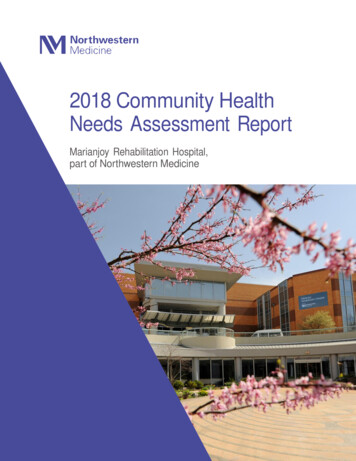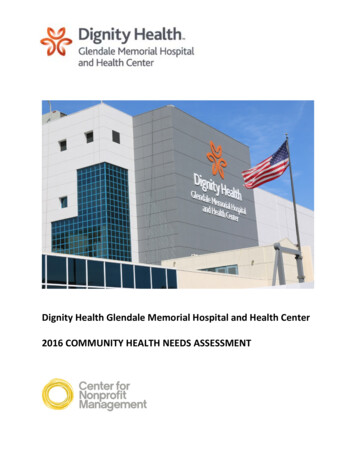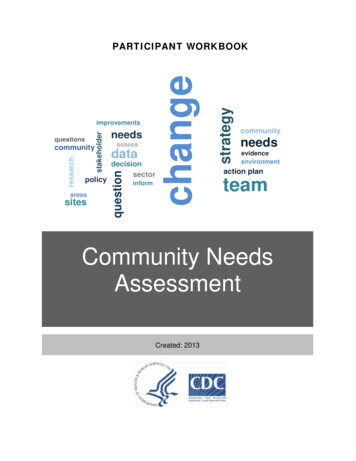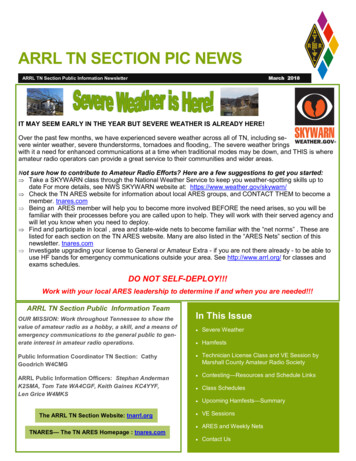
Transcription
2018 Community HealthNeeds Assessment ReportMarianjoy Rehabilitation Hospital,part of Northwestern Medicine
Northwestern MedicineContentsIntroduction. . . . . . . . . . . . . . . . . . . . . . . . . . . . . . . . . . . . . . . . . . . . . . . . . . . . . . . . . . . . . . . . . . . .3Acknowledgments. . . . . . . . . . . . . . . . . . . . . . . . . . . . . . . . . . . . . . . . . . . . . . . . . . . . . . . . . . . .4The Community Health Needs Assessment. . . . . . . . . . . . . . . . . . . . . . . . . . . . . . . . .5Development of Implementation Plan. .health needs. . . . . . . . . . . . . . . . . . . . . . . . . . . . . . .29 Actions taken to address the 2013 CHNA priority30 Appendix A. . . . . . . . . . . . . . . . . . . . . . . . . . . . . . . . . . . . . . . . . . . . . . . . . . . . . . . . . . . . . . . . . . .Appendix B38. . . . . . . . . . . . . . . . . . . . . . . . . . . . . . . . . . . . . . . . . . . . . . . . . . . . . . . . . . . . . . . . . . .40Marianjoy Rehabilitation Hospital, par t of Northwestern Medicine 2018 Community Health Needs Assessment Repor t2
Northwestern MedicineIntroductionMarianjoy Rehabilitation Hospital, part of Northwestern Medicine (MRH), has a rich history of responding to and caring forthe rehabilitative needs of residents in the Chicagoland area . The 127-bed facility located in Wheaton, Illinois, providesadvanced rehabilitation and care to members of the immediate community, and also serves as a regional destinationhospital for individuals in need of state-of-the-art rehabilitative care .MRH has 100 acute inpatient rehabilitation beds and 27 Medicare-licensed, sub-acute beds for adult and pediatric patientsrecovering from illness or injury who require intensive therapy to regain their function and independence . The mainhospital is a 170,000-square-foot facility with a number of unique inpatient and outpatient offerings, including specialtyprograms focused on the treatment of stroke, spinal cord injury, brain injury and orthopedic/musculoskeletal conditions, aswell as conditions affecting pediatric patients .MRH’s comprehensive approach to rehabilitation addresses a patient’s body, mind and spirit through personalizedtreatment programs in inpatient, comprehensive outpatient, sub-acute and physician clinics that specialize in rehabilitationmedicine . MRH also provides inpatient and outpatient pediatric rehabilitation programs and is the only pain managementprogram in Illinois accredited by CARF. The hospital includes a full-size Chartres labyrinth, therapeutic enabling gardens, ameditation room, a two-story chapel and many other unique features designed to establish it as a healing sanctuary .Additionally, the Marianjoy Assistive Rehabilitation Technology Institute (MARTI) at MRH offers solutions to everydayproblems of daily living encountered by individuals with disabilities . MARTI consists of seven distinct centers that applyadvancements in technology to benefit individuals with disabilities through maximizing functional independence andexpanding educational vocational, recreational and communicative opportunities . MARTI offers a specially designed fitnesscenter and a specialized aquatic therapy center to support the needs of individuals striving to meet their therapy goals .MRH has completed a comprehensive Community Health Needs Assessment (CHNA) to identify the highest-priorityhealth needs of residents in our community and will use this information to guide new and enhance existing effortsto improve the health of our community . As described in detail in this report, the goal of the CHNA was to implement astructured, data-driven approach to determine the health status, behaviors and needs of all residents in the MRH servicearea . Through this assessment, we identified health needs that are prevalent among residents across all socioeconomicgroups, races and ethnicities, as well as issues that highlight health disparities or disproportionately impact the medicallyunderserved and uninsured .Marianjoy Rehabilitation Hospital, par t of Northwestern Medicine 2018 Community Health Needs Assessment Repor t3
Northwestern MedicineAcknowledgmentsTo ensure organizations that impact health in central DuPage County and represent the broad interests of the communitywere meaningfully engaged in reviewing and interpreting the findings of the CHNA, an External Steering Committee (ESC)was established . The purpose of the ESC was to develop priorities among the identified areas of opportunity and assist inthe formation of a collaborative plan to address the top Priority Health Needs . ESC members include representatives fromthe following organizations:DuPage County Health DepartmentAbilityLinksDuPage Federation on Human Services ReformSPR ConsultingDuPage Health Coalition (Access DuPage)Edward Hines VA HospitalElmhurst CUSD 205Donka, Inc .Illinois Health and Hospital AssociationDuPage Workforce BoardNaperville School District 203Kensington InternationalPeople’s Resource CenterMarianjoy Rehabilitation Hospital, par t of Northwestern Medicine 2018 Community Health Needs Assessment Repor t4
Northwestern MedicineThe Community HealthNeeds AssessmentBackgroundA comprehensive CHNA was commissioned on behalf of Northwestern Medicine by Professional Research Consultants,Inc . (PRC) . PRC is a nationally recognized healthcare consulting firm with extensive experience in conducting CHNAs inhundreds of communities across the United States since 1994 .The CHNA framework consisted of a systematic, data-driven approach to determine the health status, behaviors andneeds of residents in the service area of MRH . The CHNA provided information to enable hospital leadership and keycommunity stakeholders to identify health issues of greatest concern among all residents and decide how best to committhe hospital’s resources to those areas, thereby achieving the greatest possible impact on the community’s health status .MethodologyAs previously noted, the CHNA incorporates data from both quantitative and qualitative sources . Quantitative data inputincludes primary research (the PRC Community Health Survey) and secondary research (vital statistics and other existinghealth-related data) . These quantitative components allow for trending and comparison to benchmark data at the stateand national levels . Once the data has been reviewed by MRH community health experts, executive leadership and keycommunity stakeholders identify priority areas of need in which MRH is uniquely positioned to address and respond .The entire CHNA process includes:A comprehensive identification and prioritization of needsThe identification of priority needs that MRH is most uniquely suited to addressThe development of a comprehensive Community Health Improvement Plan (CHIP) designed to guide MRH inaddressing and responding to the identified priority needs via a process-driven methodology including goaldevelopment, strategies and measurable outcomesA plan to partner with other key community stakeholders to support the remaining needsMarianjoy Rehabilitation Hospital, par t of Northwestern Medicine 2018 Community Health Needs Assessment Repor t5
Northwestern MedicineCHNA GoalsThe MRH CHNA will serve as a tool toward reaching three related goals:Improve residents’ health status, increase their life spans and elevate their overall quality1of life. A healthy community is one where its residents suffer little from physical and mentalillness and enjoy a high quality of life .Reduce the health disparities among residents. By gathering demographic information along2with health status and behavior data, it will be possible to identify population segments thatare most at-risk for various diseases and injuries . Intervention plans aimed at targeting thesesegments may then be developed to combat some of the socioeconomic factors that havehistorically had a negative impact on residents’ health .Increase accessibility to preventive services for all community residents. More accessible3preventive services will prove beneficial in accomplishing the first goal (improving health status,increasing life spans and elevating the quality of life), as well as lowering the costs associatedwith caring for late-stage diseases resulting from a lack of preventive care .Quantitative data analysis: The community health surveyQuantitative data input included primary research (the PRC Community Health Survey) and secondary research (vitalstatistics and other existing health-related data) . These quantitative components allowed for comparison to benchmarkdata at the state and national levels .Survey instrumentThe survey instrument used for the PRC Community Health Survey was based largely on the Centers for Disease Controland Prevention (CDC) Behavioral Risk Factor Surveillance System, as well as various other public health surveys andcustomized questions addressing gaps in indicator data relative to health promotion and disease prevention objectives,and other recognized health issues . The final survey instrument was developed by Northwestern Medicine and PRC .Community defined for this assessmentThe study area for the survey effort was defined as the MRH service area and analyzed at the ZIP code level, and includedthe following ZIP ieldGlendale HeightsVilla ParkWheatonWarrenvilleRoselleBloomingdaleHanover uroraLisleCarol StreamWheatonAuroraGlen st ChicagoMarianjoy Rehabilitation Hospital, par t of Northwestern Medicine 2018 Community Health Needs Assessment Repor t6
Northwestern MedicineSample approach and designTo accurately represent the population studied and minimize bias, proven telephone methodology and random-selectiontechniques were applied . While this random sampling of the population produces a highly representative sample, it is acommon and preferred practice to “weight” the raw data to further improve the representation . This was accomplishedby adjusting the results of a random sample to match the geographic distribution and demographic characteristics of thepopulation surveyed (post-stratification) to eliminate any naturally occurring bias .Specifically, once the raw data were gathered, respondents were examined by key demographic characteristics (namelygender, age, race, ethnicity and poverty status) and a statistical application package applied, weighting variables thatproduced a sample that more closely matched the population for these characteristics . While the integrity of eachindividual’s responses was maintained, one person’s responses may have contributed to the whole the same weight as,for example, 1 .1 respondents . Another respondent, whose demographic characteristics may have been slightly oversampled, may have contributed the same weight as 0 .9 respondents .The poverty descriptions used in this report are based on administrative poverty thresholds determined by the U .S .Department of Health and Human Services . These guidelines define poverty status by household income level andnumber of persons in the household . (For example, the 2017 guidelines place the poverty threshold for a family of fourat 24,400 annual household income or lower .) In this report, “low income” refers to community members living in ahousehold with defined poverty status or living just above the poverty level and earning up to twice ( 200 percent)of the poverty threshold . “Mid/high income” refers to those households living on incomes that are at least twice ( 200percent) the federal poverty level .The sample design and quality control procedures used in the data collection ensure that the sample is representative .Thus, the findings may be generalized to the total population of community members in the defined area with a highdegree of confidence .Quantitative data analysis: Public health, vital statistics and other dataA variety of existing (secondary) data sources was consulted to complement the research quality of the CHNA . Data forthe MRH service area was obtained from the following sources with specific citations included throughout the PRC report:Center for Applied Research andEnvironmental Systems (CARES)OpenStreetMap(OSM)U .S . Census BureauCenters for Disease Control and Prevention (CDC)U .S . Department of AgricultureCommunity CommonsU .S . Department of Health and Human ServicesESRI ArcGIS Map GalleryIllinois Department of Public HealthNational Cancer Institute, State Cancer ProfilesU .S . Department of Justice,Federal Bureau of InvestigationU .S . Department of Labor, Bureau ofLabor StatisticsIt must be noted that secondary data indicators reflect county-level data .Marianjoy Rehabilitation Hospital, par t of Northwestern Medicine 2018 Community Health Needs Assessment Repor t7
Northwestern MedicineBenchmark dataTrending data was utilized throughout the report when available . State and national risk factor data was utilized asan additional benchmark against which to compare local survey findings . Source data included Behavioral Risk FactorSurveillance System (BRFSS) and Trend Data published by the CDC . State and national level vital statistics were alsoprovided for comparison of secondary data indicators . Healthy People 2020 (HP2020) — a nationally recognized andevidence-based program — was also utilized as a significant source of benchmark data .Qualitative data analysis: Community stakeholder inputQualitative data input includes primary research gathered through an online key informant survey ofvarious community stakeholders .Online key informant surveyTo solicit input from key informants — individuals who have a broad interest in the health of the community — an onlinekey informant survey was included in the assessment process . A list of recommended participants was provided by MRH,which included names and contact information of physicians, public health representatives, other health professionals,social service providers and a variety of other community leaders . Potential participants were chosen because of theirability to identify primary concerns of the populations with whom they work as well as the overall community .Key informants were contacted by email, introducing the purpose of the survey and providing a link to take the onlinesurvey . Reminder emails were sent as needed to increase participation . In all, 41 community stakeholders took part in theonline key informant survey, including representatives of the following organizations:DuPage FoundationPeople’s Resource CenterDuPage Senior Citizens CouncilSamaraCareDuPage UnitedSenior Services Associates, Inc .Educare West DuPageWarrenville Park DistrictFox Valley Special Recreation AssociationWestern DuPage Special Recreation AssociationNAMI DuPageWest Chicago Public Library DistrictNorthern Illinois Food BankWinfield Park DistrictThrough this process, input was gathered from several individuals whose organizations work with low-income, minoritypopulations and other medically underserved populations . Key informants were asked to rate the degree to which varioushealth issues are a problem in their own community . Follow-up questions were asked for a description of how these issuesmay be better addressed .Marianjoy Rehabilitation Hospital, par t of Northwestern Medicine 2018 Community Health Needs Assessment Repor t8
Northwestern MedicineMinority populations representedTo Minority/medically underserved populations that were represented within the key informant survey included included:African AmericanHispanicHomelessMentally nLaotianTeen parentDisabledLow incomeUndocumentedElderlyMedicaid/Medicare recipientUnemployedDetermination of significanceDifferences noted in this report represent those determined to be significant . Statistical significance is determined basedon confidence intervals (at the 95 percent confidence level) using question-specific samples and response rates . Forpurposes of this assessment, “significance” of secondary data indicators is determined by a 5 percent variation from thecomparative measure .Information gapsWhile this MRH CHNA is quite comprehensive, it cannot measure all possible aspects of health in the community, nor canit adequately represent all possible populations of interest . It must be recognized that these information gaps might insome ways limit the ability to assess all of the community’s health needs .For example, certain population groups — such as those who are homeless, institutionalized or only speak a languageother than English or Spanish — may not be fully represented in the survey data . Other population groups — for example,pregnant women, lesbian/gay/bisexual/transgender residents, undocumented residents, and members of certain racial/ethnic or immigrant groups — might not be identifiable or might not be fully represented in numbers sufficient forindependent analysis .In terms of content, this assessment was designed to provide a comprehensive and broad picture of the health of theoverall community . However, it is recognized that there are a number of medical conditions that were notspecifically addressed .Supplemental disability surveysTo specifically assess the needs of individuals with disabilities in the MRH service area, input was also solicited from thefollowing groups through an online survey form: People who received healthcare services from the MRH network within the past two years and provided avalid e-mail address People who registered with AbilityLinks, a national, web-based community where qualified job seekers withdisabilities gain access to valuable networking opportunities Organizations that provide services and resources to people with disabilities who are affiliated with MRH and whoseek assistance following return to the communityMarianjoy Rehabilitation Hospital, par t of Northwestern Medicine 2018 Community Health Needs Assessment Repor t9
Northwestern MedicinePublic disseminationThis CHNA is available to the public and can be accessed through the following channels:View, download and/or print the document without special computer hardware or software (other than softwarethat is available to members of the public at no cost) without fee at nm th-needs-assessmentView a hard copy of the CHNA at MRH without fee upon request .Key Findings and Opportunities: Quantitative DataCommunity descriptionDuPage County encompasses 327 .41 square miles and is home to a total population of 930,412 residents, accordingto latest census estimates . The county’s population density is reported at 2,840 .83 per square mile . DuPage County ispredominately urban, with nearly all the population living in areas designated as urban .DemographicsIt is important to understand the age distribution of the population, as different age groups have unique health needsthat must be considered in planning to meet the needs of county residents . In DuPage County, 23 .8 percent of thepopulation are infants, children or adolescents age 0 to 17 years (up 0 .4 percent from the 2015 CHNA) . Another 63 .3percent are age 18 to 64 (up 1 .1 percent), while only 12 .9 percent are 65 and older (up 0 .6 percent) .Race and ethnicityIn looking at race independent of ethnicity, 79 .4 percent of residents in DuPage County are White and 4 .7 percent areBlack . When considering ethnicity, 13 .9 percent of DuPage County residents are Hispanic or Latino . The county has ahigher proportion of White residents and a lower proportion of Black residents than the state and U .S . The percentage ofHispanic and Latino residents is also lower than found in the state and U .S .Social determinants of healthHealth starts in our homes, schools, workplaces, neighborhoods and communities . We know that taking care of ourselves(including eating well, staying active, not smoking, and regularly seeing a doctor) influences our health . Our health isalso determined in part by access to social and economic opportunities, resources that are available in the community,quality education, workplace safety, environmental factors and our personal relationships . The conditions in which we liveexplain, in part, why some Americans are healthier than others .PovertyThe U .S . Census Bureau American Community Survey 5-Year Estimates (2011 to 2015) show 7 .4 percent of theDuPage County population living below 100 percent of the Federal Poverty Level . This represents an increaseof 0 .5 percent over 2009 to 2013 census data . A total estimated 19 .1 percent of residents (175,652 individuals)live below 200 percent of the Federal Poverty Level . This represents a notable 10 .5 percent increase (6,807individuals) from our previous assessment .Marianjoy Rehabilitation Hospital, par t of Northwestern Medicine 2018 Community Health Needs Assessment Repor t10
Northwestern MedicineEducation and employmentAmong the Kane County population age 25 and older, an estimated 16 .9 percent (56,865 people) do not havea high school education, which was a less favorable number than state (11 .7 percent) and national(13 .0 percent) findings .According to data derived from the Illinois Department of Employment Security, the unemployment rate inKane County was 3 .8 percent in April 2018, trending more favorably than both the state and nationalunemployment rates . .Morbidity and mortalityA total of 64 .3 percent of MRH survey respondents rated their overall health as “excellent” or “very good,” with 9 .5percent describing their overall health status as “fair” or “poor .” The remaining 26 .1 percent rated their health as “good .”Activity limitationsAn individual can develop a disabling impairment or chronic condition at any point in life . According to HP2020, peoplewith disabilities are more likely to: Experience difficulties or delays in gettingthe health care needed Not have had an annual dental exam Not have had a mammogram in the past two years Not have had a Pap test within the past three years Not engage in fitness activities Use tobacco Be overweight or obese Have high blood pressure Experience symptoms of psychological distress Receive less social-emotional support Have lower employment ratesFurther, there are many social and physical factors that influence the health of people with disabilities . The followingthree areas for public health action have been identified, using the International Classification of Functioning, Disabilityand Health (ICF) and the three World Health Organization (WHO) principles of action for addressing health determinants . Improve the conditions of daily life by encouraging communities to be accessible so all can live in, move through, andinteract with their environment; encouraging community living; and removing barriers in the environment using bothphysical universal design concepts and operational policy shifts . Address the inequitable distribution of resources among people with disabilities and those without disabilitiesby increasing appropriate health care for people with disabilities; education and work opportunities; social participation;and access to needed technologies and assistive supports .Marianjoy Rehabilitation Hospital, par t of Northwestern Medicine 2018 Community Health Needs Assessment Repor t11
Northwestern Medicine Expand the knowledge base and raise awareness about determinants of health for people with disabilities byincreasing the inclusion of people with disabilities in public health data collection efforts across the lifespan; theinclusion of people with disabilities in health promotion activities; and the expansion of disability and health trainingopportunities for public health and healthcare professionals .A total of 12 .0 percent of survey respondents identified a limitation in activities in some way due to a physical, mental oremotional problem . Limitations were higher in women (13 .6 percent) than men (10 .3 percent) and highest among the 65 year range (14 .7 percent) . Additionally, the prevalence was higher in low-income individuals (27.6 percent) and Hispanics(21 .5 percent) .Individual activity limitation indicators included:Difficulty walking or climbing stairsDifficulty concentrating, remembering or making decisionsDifficulty doing errands aloneDifficulty dressing or bathingMental health statusA total of 68 .6 percent of respondents reported their mental health as “excellent” or “very good” with 19 .7 percentreporting “good” and 11 .7 percent reporting “fair” or “poor .” Those reporting “fair” or “poor” mental health weremost likely to be: Women (16 .5 percent) Individuals ages 19 to 39 years (15 .2 percent) Low-income individuals (31 .5 percent) African Americans (16 .2 percent)A total of 19 .1 percent of adults self-reported being diagnosed with a depressive disorder . This was higher than statetrends, but lower than U .S . rates . This represents an increase from 15 .9 percent in 2015 . Additionally, 22 .8 percent ofrespondents reported symptoms of chronic depression lasting two or more years . This was lower than U .S . data andtrending similar to 2009 to 2015 rates (22 .0 to 25 .2 percent) . The rate was highest in: Women (27.4 percent) Individuals ages 18 to 39 years (24 percent) Low-income individuals (36 .3 percent) Asians (25 .5 percent)Marianjoy Rehabilitation Hospital, par t of Northwestern Medicine 2018 Community Health Needs Assessment Repor t12
Northwestern MedicineBetween 2013 and 2015, the annual average age-adjusted suicide mortality rate was 8 .9 deaths per 100,000 populationin DuPage County — higher than trending rates, but lower than state and national rates . A total of 27.3 percent of surveyrespondents reported having ever sought treatment from a professional for a mental or emotional problem, comparedto 30 .8 percent nationally . Additionally, 11 .7 percent acknowledged currently taking medication/receiving mental healthtreatment as compared to 13 .9 percent nationally .A total of 5 .5 percent of survey respondents acknowledged being unable to get mental health services when needed inthe past year, compared to the U .S . rate of 6 .8 percent . Rates were highest in: Women (6 .8 percent) Individuals ages 18 to 39 (11 .4 percent) Low-income individuals (8 .0 percent) Hispanics (21 .8 percent)Mental health was rated as a major problem by 64 .7 percent of key informants, citing challenges such as: Access to care/services Denial/stigma Affordability Inadequate fundingMorbidity and mortalityTogether, cardiovascular disease (heart disease and stroke) and cancers accounted for more than one-half of alldeaths in DuPage County . The top five 2013 to 2015 age-adjusted death rates per 100,000 population for selectedcauses included: Cancers (143 .0) Diseases of the heart (131 .8) Stroke (30 .8) Chronic lower respiratory diseases (29 .9) Unintentional injuries (23 .6)All rates were lower than state and national rates .Marianjoy Rehabilitation Hospital, par t of Northwestern Medicine 2018 Community Health Needs Assessment Repor t13
Northwestern MedicineCardiovascular diseaseHeart disease is the leading cause of death in the U .S ., with stroke following as the third-leading cause . Together, heartdisease and stroke are among the most widespread and costly health problems facing our nation today, accounting formore than 500 billion in healthcare expenditures . HP2020 stresses that the risk of Americans developing and dyingfrom cardiovascular disease would be substantially reduced if changes were made in diet, physical activity andmanagement of high blood pressure, cholesterol and smoking . Fortunately, these deaths are mostly preventable,especially if intervention is provided across the lifespan of the disease, from early education, prevention and screeningto early diagnosis, prompt treatment and comprehensive aftercare . In planning responses to the priority needs of theircommunities, hospitals can positively impact the health burdens of all chronic diseases by addressing the disease acrossthe continuum of its lifespan .Together, cardiovascular disease (heart disease and stroke) accounted for 27 .9 percent of all deaths in DuPageCounty .A total of 6 .2 percent of survey respondents acknowledged having been told by their healthcare A total of 33 .4percent of adults reported being told at some point that their blood pressure was high, exceeding the HP2020target of 26 .9 percent or lower . This finding represented an increase from 32 .7 percent in the 2015 MRH CHNA .Among adults with multiple high blood pressure readings, 83 .0 percent reported taking action to control theirlevels .A total of 36 .5 percent of adults reported a diagnosis of high cholesterol . This represents a notable increase from34 .3 percent in our 2015 assessment and an HP2020 target of 13 .5 percent or lower .Among adults with self-reported high blood cholesterol readings, 81 .3 percent reported taking action to controltheir levels .Regarding total risk of cardiovascular disease, 83 .6 percent of respondents reported one or more risk factors,including being overweight, smoking cigarettes, being physically inactive, or having high blood pressure or highcholesterol levels . Risk and/or behaviors were highest in:Men (88 .4 percent)Low-income individuals (93 .8 percent)Individuals 65 years and over (90 .9 percent)Hispanics (98 percent) .Heart disease and stroke were rated as a major (31 .3 percent) and moderate (34 .4 percent) problem by keyinformants citing concerns such as:General wellness, physical activityand nutrition being ignoredStressFast-paced livesDietGeneticsMarianjoy Rehabilitation Hospital, par t of Northwestern Medicine 2018 Community Health Needs Assessment Repor t14
Northwestern MedicineCancerContinued advances in cancer research, detection and treatment have resulted
DuPage Federation on Human Services Reform DuPage Health Coalition (Access DuPage) Elmhurst CUSD 205 Illinois Health and Hospital Association Naperville School District K203 People’s Resource Center Abilit










